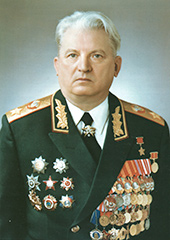Semyon Konstantinovich Kurkotkin | |
|---|---|
 Kurkotkin in 1972 | |
| Born | 13 February 1917 Zaprudnaya near Ramenskoye, Bronnitsky Uyezd, Moscow Governorate, Russian Empire |
| Died | 16 September 1990 (aged 73) Moscow, Russian SFSR, Soviet Union |
| Buried | |
| Allegiance | |
| Service | Red Army (Soviet Army from 1946) |
| Years of service | 1937–1990 |
| Rank | |
| Commands | |
| Battles / wars | World War II |
| Awards | Hero of the Soviet Union |
Semyon Konstantinovich Kurkotkin (Russian: Семё́н Константи́нович Курко́ткин; 13 February 1917 – 16 September 1990) was a Soviet military commander and a Marshal of the Soviet Union.
Born near Moscow, Kurkotkin attended a technical college in the capital before joining the Red Army in 1937. He graduated from a tank school and began his career as a political officer in armored units. After political officers were stripped of command responsibility in late 1942 Kurkotkin became a battalion commander, rising to second-in-command of a brigade in late 1943. After his superior was killed, he became acting commander of a brigade of the 4th Guards Tank Corps, which he led in the fighting in western Ukraine during the winter of 1943–1944. As a result of his performance, Kurkotkin was selected for permanent brigade command in late 1944, leading another brigade of the corps in the advance into Germany in 1945.
After the war Kurkotkin graduated from the Military Academy for Armored and Mechanized Forces and became a tank division commander in 1951. He graduated from the Military Academy of the General Staff in 1958, and a succession of corps and army commands followed before Kurkotkin became first deputy commander-in-chief of the Group of Soviet Forces in Germany, and commander-in-chief of the Transcaucasus Military District and the Group of Soviet Forces in Germany during the late 1960s and early 1970s. Kurkotkin was appointed chief of the Rear Services of the Soviet Armed Forces in 1972, a position he held until his retirement in 1988. He received the title Hero of the Soviet Union in 1981 and became a Marshal of the Soviet Union in 1983.